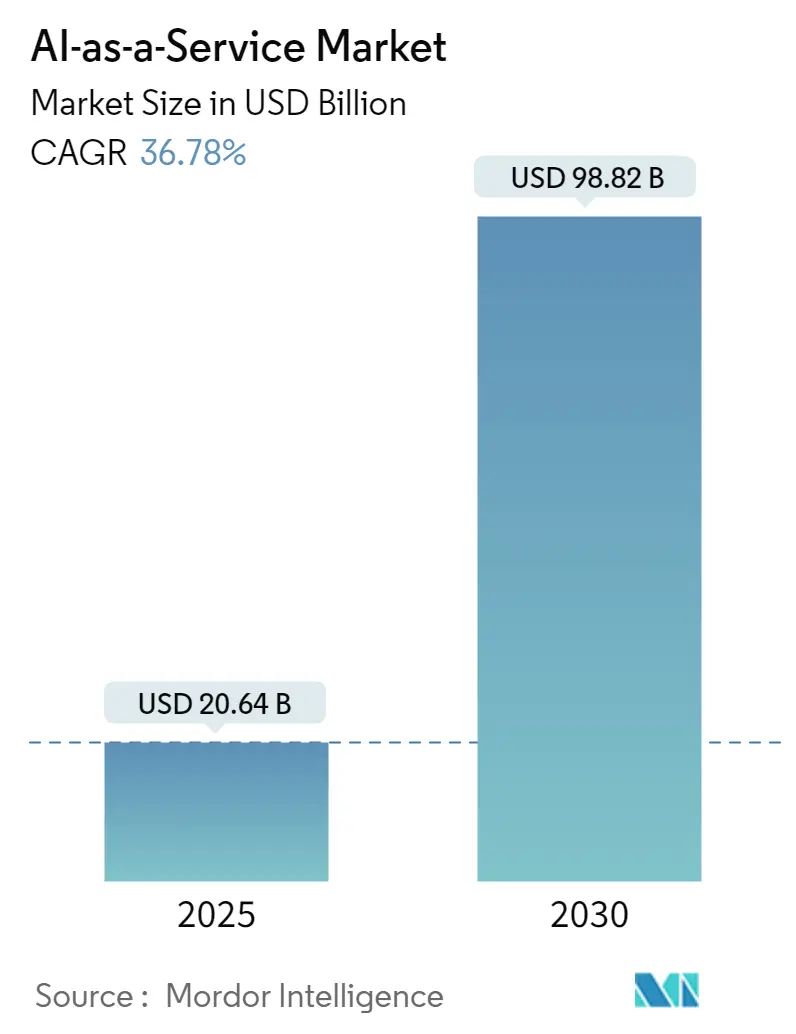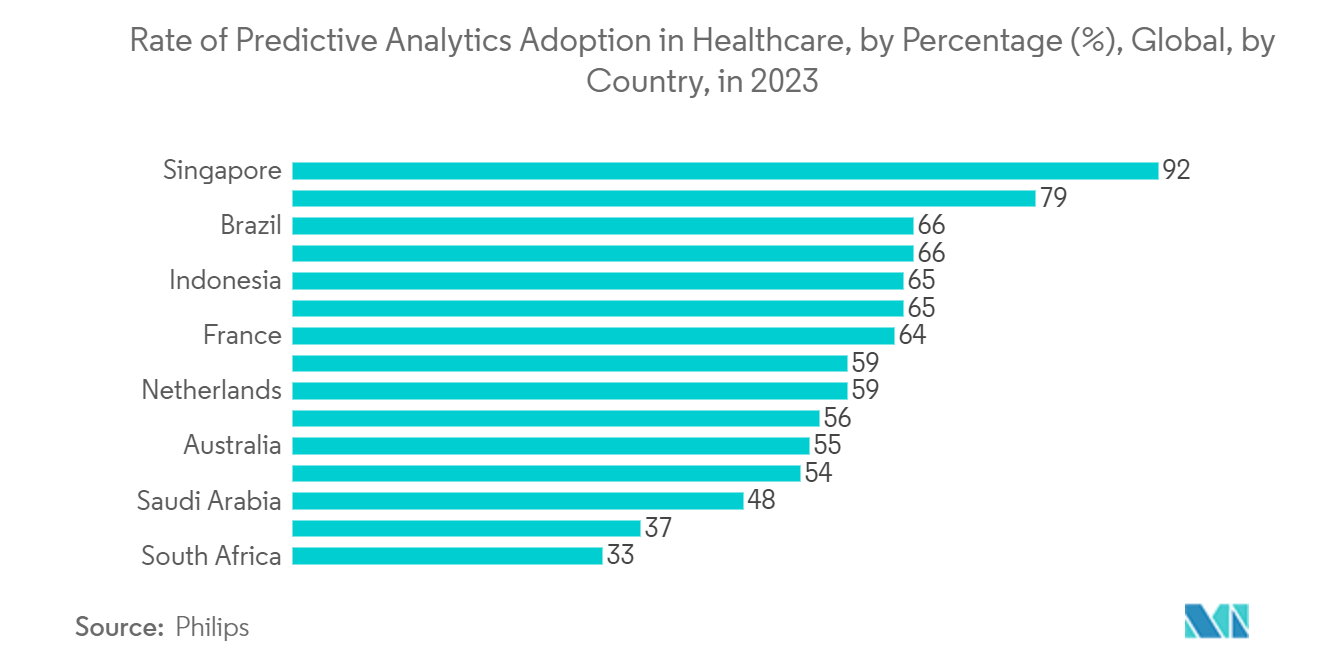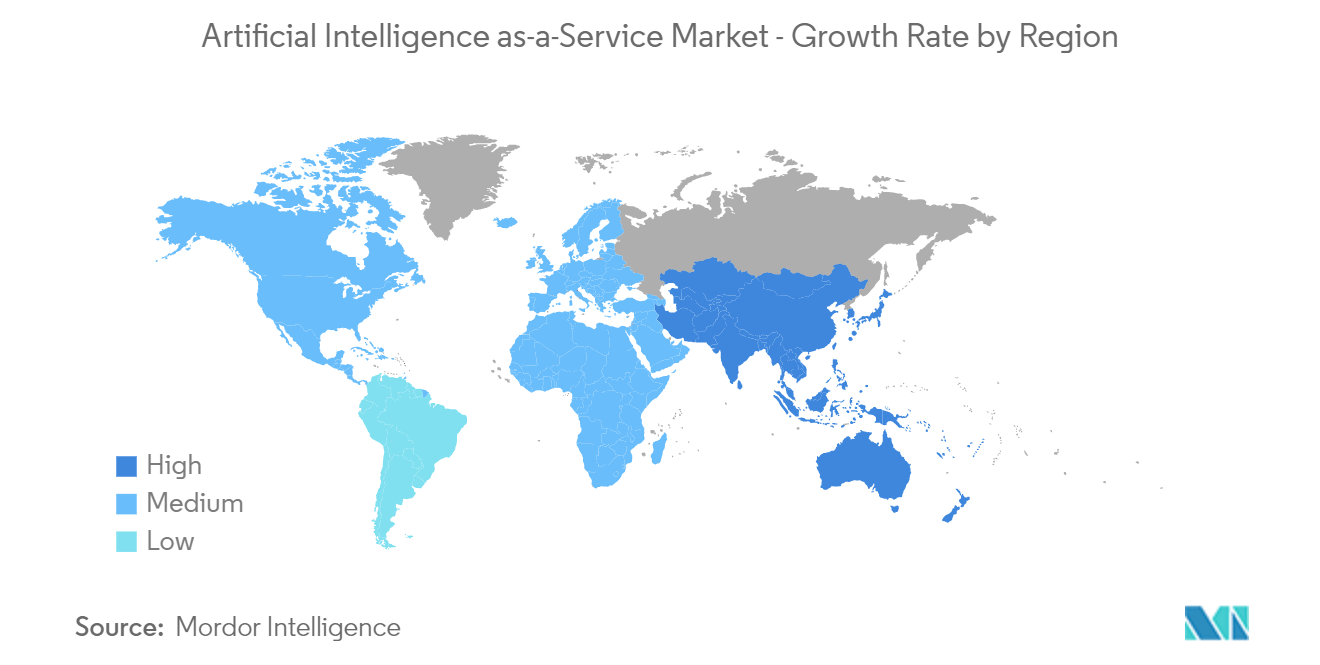Artificial Intelligence as a Service (AIaaS) Market Size
Artificial Intelligence as a Service (AIaaS) Market Analysis
The AI-as-a-Service Market size is estimated at USD 20.64 billion in 2025, and is expected to reach USD 98.82 billion by 2030, at a CAGR of 36.78% during the forecast period (2025-2030).
With the increasing number of enterprises and competition, companies are rigorously trying to integrate artificial intelligence (AI) technology into their application, business, analytics, and services. Moreover, companies are trying to reduce their operational cost to increase profit margins, due to which Artificial Intelligence-as-a-Service (AIaaS) is gaining more prominence over the cloud. Notably, companies are more interested in cloud-based machine learning, which helps in experimenting with their offerings.
- The rising trend of multi-cloud functioning and the growing need for cloud-based intelligence services are also increasing the demand for AI as a service. According to IBM, by 2021, 98% of the organization's plans will adopt multi-cloud architectures, with only 41% having a multi-cloud management strategy and just 38% having procedures and tools to operate a multi-cloud environment. This creates a massive opportunity for AI services.
- Furthermore, the IBM AI adoption index 2022 states, " A tipping point has been reached in using artificial intelligence (AI) and its effects on businesses and society. The adoption rate of AI globally increased significantly and is at 35%, up four points from the previous year. And the usage of AI is nearly universal in several sectors and nations.
- Organizations worldwide are quickly gaining new advantages and efficiencies from AI thanks to new automation capabilities, improved usability and accessibility, and a more comprehensive range of tried-and-true use cases. Virtual assistants and other ready-made corporate solutions like IT incorporate AI into their operations. The fact that 44% of firms are working to integrate AI into current apps and processes supports the argument that accessibility is important.
- Many government organizations, especially in emerging economies, also understand the benefits and power of AI; hence, they are extensively promoting AI-based infrastructure development. For instance, Niti Aayog in India launched a national program on AI, including R&D, with increased budget allocation for Digital India to promote AI, machine learning, 3D printing, and other technologies.
Artificial Intelligence as a Service (AIaaS) Market Trends
Increasing Demand for Predictive and Analytics Solutions is Expected to Drive Market Growth
- The increasing demand for predictive and analytics solutions would drive the artificial intelligence-as-a-service (AIaaS) market. AIaaS refers to outsourcing artificial intelligence (AI) computational and analytical capabilities to third-party service providers offering AI solutions and tools over the Internet.
- With advancements in AI technology, businesses across various industries recognize the potential benefits of integrating AI into their operations. AI can help improve efficiency, enhance customer experiences, and make data-driven decisions. However, implementing AI infrastructure and developing AI models in-house can take time and effort. AIaaS provides a cost-effective and convenient alternative by offering pre-built AI solutions and platforms.
- AIaaS platforms offer scalability and flexibility, allowing businesses to access AI resources according to their requirements. As the demand for predictive and analytics solutions grows, companies can easily scale up their AI capabilities by leveraging AIaaS services. This flexibility enables organizations to adapt to changing business needs without significant upfront investments in infrastructure and expertise.
- AIaaS eliminates the need for businesses to invest in expensive hardware, software, and specialized AI expertise. By leveraging AIaaS solutions, companies can access AI capabilities on a subscription or pay-per-use basis, reducing upfront costs and making AI more accessible to a broader range of organizations. This cost efficiency is particularly beneficial.
- Adopting predictive analytics in healthcare requires robust AI capabilities, computational power, and expertise. AIaaS platforms offer healthcare organizations the convenience and accessibility of accessing AI and predictive analytics tools without significant upfront investments. As healthcare providers and payers increasingly recognize the value of predictive analytics, the demand for AIaaS solutions in the healthcare sector is expected to grow, driving the overall AIaaS market.
- According to Philips, as of the second month of the previous year, 92 percent of healthcare leaders surveyed in Singapore reported that they had either implemented or were implementing predictive analytics in their healthcare organization, the highest adoption rate among all countries examined. China stood second with a 79 percent adoption rate, followed by Brazil and the United States with 66 percent.
North America is Expected to Hold Significant Market Share
- The North American Artificial Intelligence-as-a-Service (AIaaS) market is one of the largest markets for AIaaS solutions. North America is home to major technology hubs, such as Silicon Valley, which foster innovation and drive technological advancements. The region has a robust infrastructure and a highly skilled workforce, enabling the development and deployment of AI technologies. This technological ecosystem creates a favorable environment for AIaaS providers to offer solutions and services.
- The United States has a robust innovation ecosystem fueled by strategic federal investments in advanced technology, complemented by the presence of visionary scientists and entrepreneurs coming together from across the world and renowned research institutions, which have propelled the development of AI in the North American region.
- According to the National Security Commission on Artificial Intelligence, its final report proposed that Congress increase federal R&D funding for AI by a factor of two annually, up to a total of USD 32 billion in fiscal 2026. The federal R&D budget was expected to be increased by 28% from FY 2021 authorized levels to more than USD 204 billion under the Biden administration's fiscal 2023 budget plan. The National AI Research Institutes, both new and established, would get some of those funds. To address the difficulties of AI research and workforce development, these institutes bring together the commercial sector, organizations, academics, and federal, state, and municipal authorities. Such government initiatives for the development of AI will drive the market.
- The North American region has a thriving AI industry with numerous startups, technology giants, and research institutions focused on advancing AI technologies. This ecosystem fosters innovation and drives demand for AIaaS solutions. Companies in sectors like healthcare, finance, retail, and manufacturing are actively adopting AI technologies to gain a competitive edge, further fueling the growth of the AIaaS market in North America.
- Many organizations in North America are undergoing digital transformation initiatives, aiming to leverage AI technologies to enhance their operations, optimize processes, and gain insights from their data. AIaaS plays a crucial role in these initiatives, providing businesses with a scalable and cost-effective way to access AI capabilities without significant upfront investments in infrastructure and expertise-the need for businesses to remain competitive drives the demand for AIaaS solutions.
Artificial Intelligence as a Service (AIaaS) Industry Overview
The artificial intelligence-as-a-service (AIaaS) market is highly fragmented, with the presence of major players like Microsoft Corporation, Google LLC, Amazon Web Services, Inc., IBM Corporation, and BigML Inc. Players in the market are adopting strategies such as partnerships and acquisitions to enhance their product offerings and gain a sustainable competitive advantage.
In July 2022, IBM announced the acquisition of Databand.ai, a major provider of data observability software that assisted organizations in resolving data issues such as mistakes, pipeline failures, and low quality before they influenced their bottom line. The announcement expanded IBM's software portfolio across data, AI, and automation to cover the whole spectrum of observability. It assisted organizations in ensuring that trustworthy data was in the hands of the appropriate individuals at the right time.
In June 2022, Amazon launched "Code Whisperer,' a new service that used machine learning to generate code suggestions for software developers. It is the first addition to its cloud offering. This tool, currently in preview, is intended to help programmers write code faster and build training datasets for their artificial intelligence projects.
Artificial Intelligence as a Service (AIaaS) Market Leaders
-
Microsoft Corporation
-
Google LLC
-
Amazon Web Services, Inc.
-
IBM Corporation
-
BigML Inc
- *Disclaimer: Major Players sorted in no particular order
Artificial Intelligence as a Service (AIaaS) Market News
- June 2024: Tata Consultancy Services Ltd (TCS) launched TCS AI WisdomNext, an AI platform from its newly established AI.Cloud division, enabling clients to adopt advanced technologies like generative AI (GenAI) affordably. This launch aligns with the broader trend of IT firms pivoting towards GenAI. Notably, TCS, headquartered in Mumbai, was the pioneer among Indian IT firms to consolidate its AI and cloud divisions into the unified entity, AI.Cloud.
- May 2024: SK Telecom Co., a mobile carrier in South Korea, is launching tailored services that link prominent large language models (LLMs) with the systems of corporate clients. This move is part of SK Telecom's strategy to pivot towards AI-driven growth avenues, especially as its traditional telecom business reaches saturation. In the upcoming third quarter, SK Telecom will debut a corporate AI minutes service, allowing clients to select their preferred LLMs over a predetermined deep learning algorithm.
Artificial Intelligence as a Service (AIaaS) Industry Segmentation
Artificial Intelligence-as-a-Service (AIaaS) accounts for a third-party offering to outsource artificial intelligence. It allows companies or end-users to experiment with AI for various purposes by limiting initial investment and lowering risk.
The artificial intelligence-as-a-service (AIaaS) market is segmented by type of cloud (public, private, hybrid), by organization size (small and medium enterprises, large enterprises), by end-user industry (BFSI, retail, healthcare, IT and telecommunications, manufacturing, energy), and by geography (North America, Europe, Asia-Pacific, Latin America, the Middle East, and Africa). The market sizes and forecasts are provided in terms of value in USD for all the above segments.
| By Deployment | Public |
| Private | |
| Hybrid | |
| By Organization Size | Small and Medium Enterprise |
| Large Enterprise | |
| By End-user Industry | BFSI |
| Retail | |
| Healthcare | |
| IT and Telecom | |
| Manufacturing | |
| Energy | |
| Other End-user Industries | |
| By Geography*** | North America |
| Europe | |
| Asia | |
| Australia and New Zealand | |
| Latin America | |
| Middle East and Africa |
Artificial Intelligence as a Service (AIaaS) Market Research FAQs
How big is the AI-as-a-Service Market?
The AI-as-a-Service Market size is expected to reach USD 20.64 billion in 2025 and grow at a CAGR of 36.78% to reach USD 98.82 billion by 2030.
What is the current AI-as-a-Service Market size?
In 2025, the AI-as-a-Service Market size is expected to reach USD 20.64 billion.
Who are the key players in AI-as-a-Service Market?
Microsoft Corporation, Google LLC, Amazon Web Services, Inc., IBM Corporation and BigML Inc are the major companies operating in the AI-as-a-Service Market.
Which is the fastest growing region in AI-as-a-Service Market?
Asia Pacific is estimated to grow at the highest CAGR over the forecast period (2025-2030).
Which region has the biggest share in AI-as-a-Service Market?
In 2025, the North America accounts for the largest market share in AI-as-a-Service Market.
What years does this AI-as-a-Service Market cover, and what was the market size in 2024?
In 2024, the AI-as-a-Service Market size was estimated at USD 13.05 billion. The report covers the AI-as-a-Service Market historical market size for years: 2019, 2020, 2021, 2022, 2023 and 2024. The report also forecasts the AI-as-a-Service Market size for years: 2025, 2026, 2027, 2028, 2029 and 2030.
Our Best Selling Reports
Artificial Intelligence as a Service Industry Report
Statistics for the 2025 AI-as-a-Service market share, size and revenue growth rate, created by Mordor Intelligence™ Industry Reports. AI-as-a-Service analysis includes a market forecast outlook for 2025 to 2030 and historical overview. Get a sample of this industry analysis as a free report PDF download.

_Market_Major_Players_Logo.webp)



_Market_Concentration.webp)

